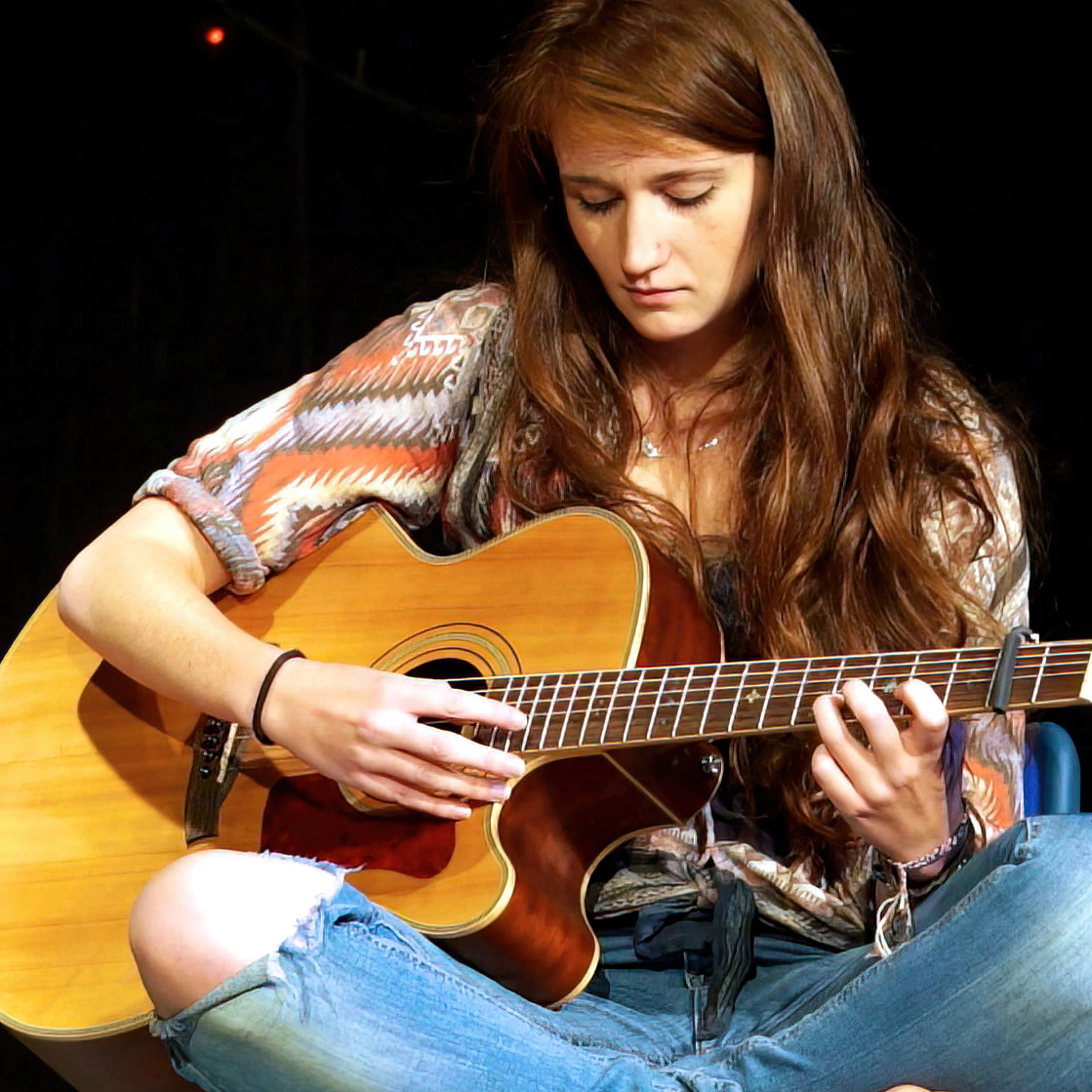Justin “GuitarSlayer” Lyons on designing a glow-in-the-dark guitar to bring session players into the limelight and the guitar lesson he learned from Machine Gun Kelly
He got his start in K-pop, and now “GuitarSlayer” has worked in just about every genre under the sun – he shares his tips on how to go pro, why he watches videos of Prince, Hendrix and SRV before he hits the stage, and how he divided up guitar parts with Sophie Lloyd in MGK's live band
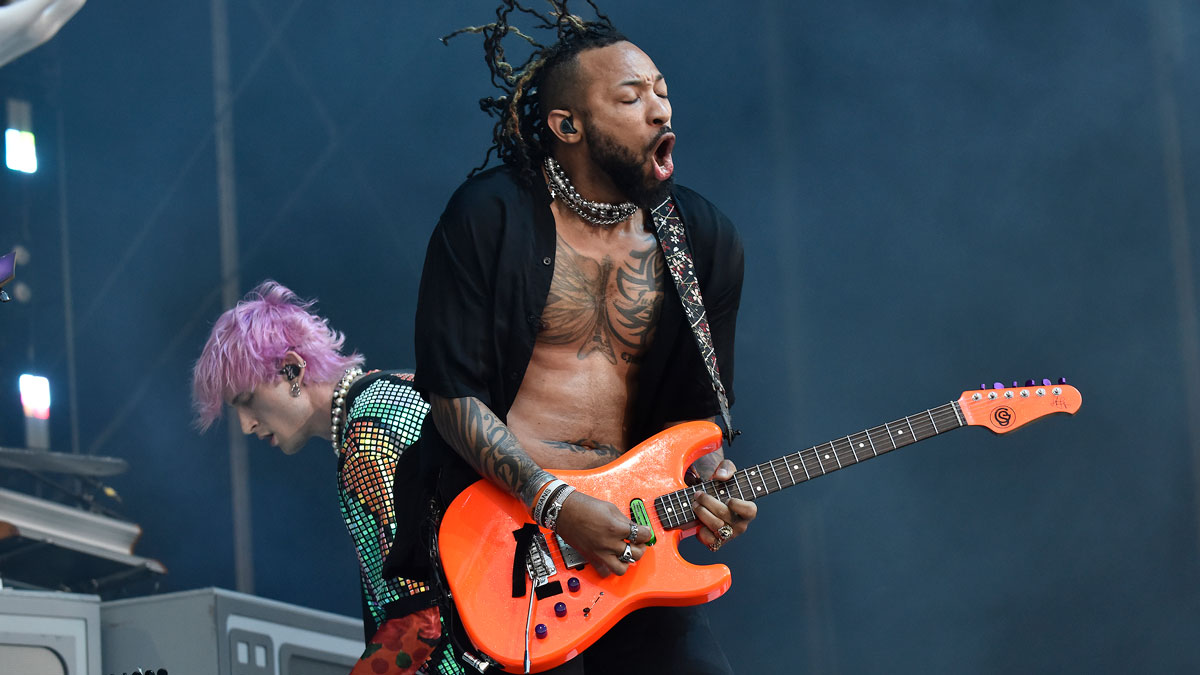
Born into a musical family and raised in church on gospel music, Justin “GuitarSlayer” Lyons has been playing the guitar since he was big enough to hold one. He learned to play by ear – internalizing melodies hummed by his mother, looking up to his guitar player father, and listening to a cassette of B.B. King’s The Thrill Is Gone over and over until the sounds became like a second language.
“As a five- or six-year-old listening to the blues, that really started to cultivate my sound, my technique, my gospel chops and my blues chops,” recalls the guitarist - now in his early 30s and with 15 years of working as a professional session guitarist and sideman under his belt.
In his youth, a predilection for “sliding around on the floor, kicking up in the air and breaking guitars,” earned him the “GuitarSlayer” nickname that has stuck ever since, and which Lyons proudly claims now gets used more than his “government name”.
But, beyond having sent a guitar or two to ‘rest in pieces’, his lethal, multi-genre chops are what have helped him build one of the most impressive CVs in the business. He’s perfected jazz, funk, pop, R&B and rock playing styles, and worked with artists as diverse as Machine Gun Kelly, Lil Wayne, Chrisette Michele, Mindless Behavior, Tank, Tamela Mann, Vivian Green and Bobby Brown.
“The only genre that I have not tapped into yet that I’m excited to tap into is country,” he enthuses.
But the Dallas, Texas native got his first major break in a much more unlikely genre: Korean pop music.
“One of my friends hit me up and told me that there was a tweet from Lil Wayne’s musical director looking for a guitarist for an overseas opportunity,” explains Lyons. “So, I just responded to him and said, 'Hey, I have my passport in hand and I’m ready to go to the airport right now. What do you need?'”
Get The Pick Newsletter
All the latest guitar news, interviews, lessons, reviews, deals and more, direct to your inbox!
The sheer cojones of Lyons’ response placed him a head and shoulders above other candidates and, despite having never heard of the genre at the time, he was invited to begin working and touring with some of the biggest names in K-pop – such as BlackPink, GDragon, and BigBang.
I’ve got to a point now in my career – and this might sound crazy – but I mainly practice in my mind
“Our band was called The Band Six, at the time, and they hired us to come and urbanize their music. The live sound and live flavor that everybody is experiencing today was generated from us back in 2012,” recalls Lyons.
His willingness to seize an opportunity by setting aside preconceived notions of personal musical preferences is a lesson worth remembering for any aspiring session guitarist.
“As musicians, it’s fun to jam and it’s fun to play, but we are a business entity,” advises the now seasoned pro. “It changed my life overnight and started my journey.”
Fast-forward to today, and Lyons has been cranking the volume and unleashing his badass inner showman to vast arena audiences as the lead guitarist in rapper-turned-pop-punk-superstar Machine Gun Kelly’s live band.
Playing to hundreds of thousands across both MGK’s Tickets To My Downfall and Mainstream Sellout tours – the latter of which also featured shred sensation Sophie Lloyd as part of the band – Lyons has become one of the most highly successful, adaptable and knowledgeable players working today.
While home from the road, we caught up for more session world insights, tips for getting tour ready, and the gear he couldn’t be without…
What’s your practice routine like when you’ve got a huge tour coming up?
“I’ve got to a point now in my career – and this might sound crazy – but I mainly practice in my mind. Over the years, I’ve already built up the dexterity in my hands, and I’ve also practiced whatever song or whatever tour a million times, but I still chart it all out just for memorization’s sake. Now, I practice in my head – just going over my notes and making sure that when I’m on stage, I can still visualize the notes that are shooting out at me.
“Not only that, I’ve always gotta rock with my three favourite guitar players’ YouTube clips. One is Prince and I’ve got to watch a YouTube clip of Prince’s best solos. I have to watch Jimi Hendrix and I have to watch some Stevie Ray Vaughan. All these players are different in their own right and they all have a different swag, a different flavor and taste that just gets me pumped up and ready for my approach before I get up on stage.”
Is that for showmanship inspiration as much as the actual playing?
Machine Gun Kelly was like, 'Hey Justin, give me a solo.' I started doing some something tasty and face-melting but he just said, 'Whoa, give me something simple so that a guy that cannot play guitar could pick one up and do exactly what you did'
“You’ve got to look the part, so it’s definitely about the showmanship, and I learned that from Prince.
“His showmanship was everything: how he spun with the guitar, how he’d break, how he’d look at the camera and wink or something. All of those little things just add to the show, and I think more players could take note of that.”
What’s the dynamic like when you’re working alongside guitarists like Machine Gun Kelly and Sophie Lloyd?
“The Mainstream Sellout was Sophie’s first world tour ever, so knowing that I already had 15 years under my belt and that this was her first year, I wanted to make sure she was good, because we’re a team.
“My playing ability was definitely different than both her and Colson [Baker, aka Machine Gun Kelly], so they were definitely trusting me to come up with some things. Then we’d all work together as far as choreographing moves and what not. I just know what to do when lights hit, I know where the cameras are, and that takes years of exercise, practice and teambuilding.”
Have you had to learn any specific techniques for any of the tours you’ve been part of?
“I’ll say that I had to learn a little tip. It’s a small thing but it helped me a great deal. I was in the studio with Machine Gun Kelly and we were working on some record, and he was like, 'Hey Justin, give me a solo.'
“I started doing some riffs of what I thought was tasty and face-melting but he just said, 'Whoa, give me something simple so that a guy that cannot play guitar could pick one up and do exactly what you did.'
“That little tip there blew my mind because I really had to simplify my thinking. When it’s digestible for everybody, you get to feed more people.”
It takes maturity to know how to not overplay…
“Yes, especially with three guitars on stage and you’re finding or knowing your place. Coming from the K-pop world, it was a different structure of delivery. Every other show up until now, I'd been the only guitarist. Now, we have three guitars, so giving Sophie and Colson parts and making it an in sync thing has been – I won’t say challenging – but it has been fun and different.”
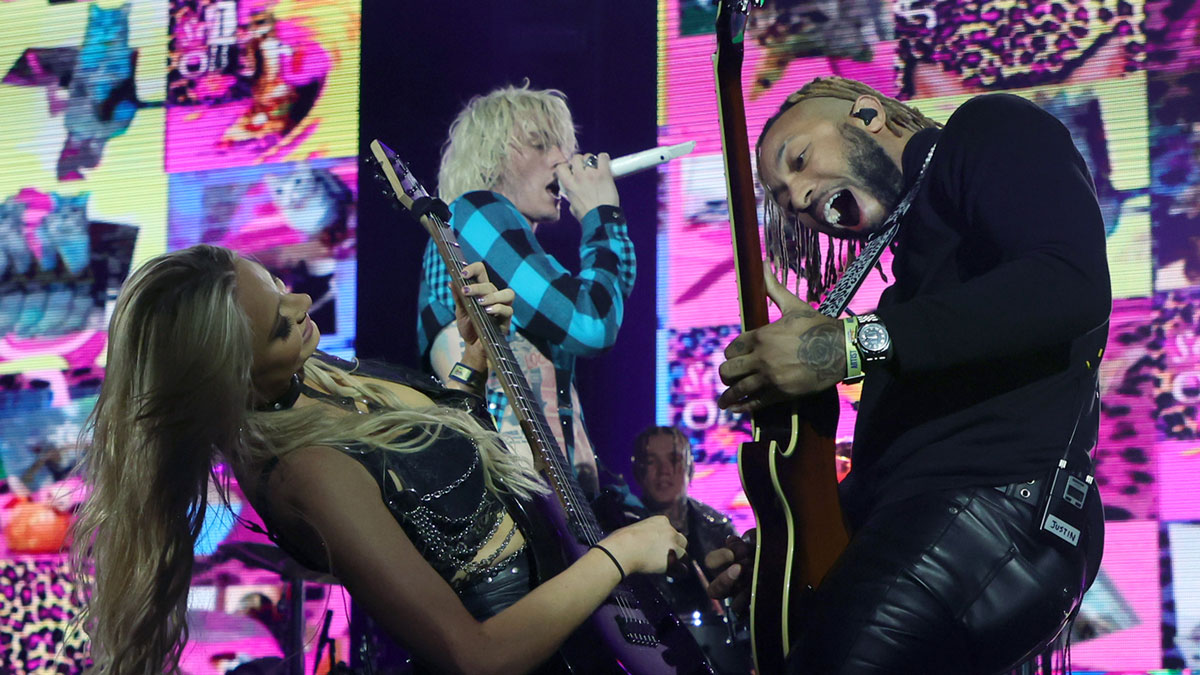
Given that your role is partly to help fulfil another artist’s vision, would you say you have to be egoless to make it in this business?
“I can’t have an ego. If you call me for a job, you call me for a purpose. When I first got the call for Machine Gun Kelly, I sat down with management and said, 'What’s the goal here? What do you guys want to accomplish and what do you guys want this to look like?' I do that so I can mentally prepare for being on the same page. If I’m going in there worrying about myself, then I’m in trouble.”
Do you use different guitars for different tours and how do you go about making your choices?
“I listen to the music and I sit with it. Of course, a single coil is going to give you one tone, and a humbucker is going to give you another tone. I just make sure that on tour I have a versatile guitar.
Musicians are in the background… when the black lights come on stage, you just don’t see us. So, I made a guitar that glows in the dark
“For the longest time, a PRS was my go to guitar, and I’ve always got to keep one on me just because of the versatility – from Strat to humbucker sounds. Lately, I’ve been loving the Schecter Diamond Series guitars that are shaped like a Les Paul. It’s a sexy guitar and it just fits.
“It’s a case of going off the song and you can listen to something and kind of tell what guitar is what. I don’t mind asking the guys that produced the record what guitar and what stomp pedals got used so I can incorporate that with my tones.”
Tell us about your most unique instrument…
“Musicians are in the background and the artists or ‘the entity’ get propelled a lot. I was like, ‘Man, all of these companies just want me to play a black guitar’, and when the black lights come on stage, you just don’t see us. So, I made a guitar that glows in the dark.
“Me and a buddy of mine had the idea and we built it so we don’t have to continue to get backwashed. Politely, we can still be in the background, but twinkle.
“We started it from scratch. I wish I’d had backing from a guitar company so we could have done at least an exclusive line of a hundred or two-hundred, just so it could be a special collectors’ item. It’s orange, which is my favourite color because it represents high vibration and happiness.
“I was excited about that guitar and it was a fun project where a lot of people saw the guitar but they didn’t know the story behind it.”
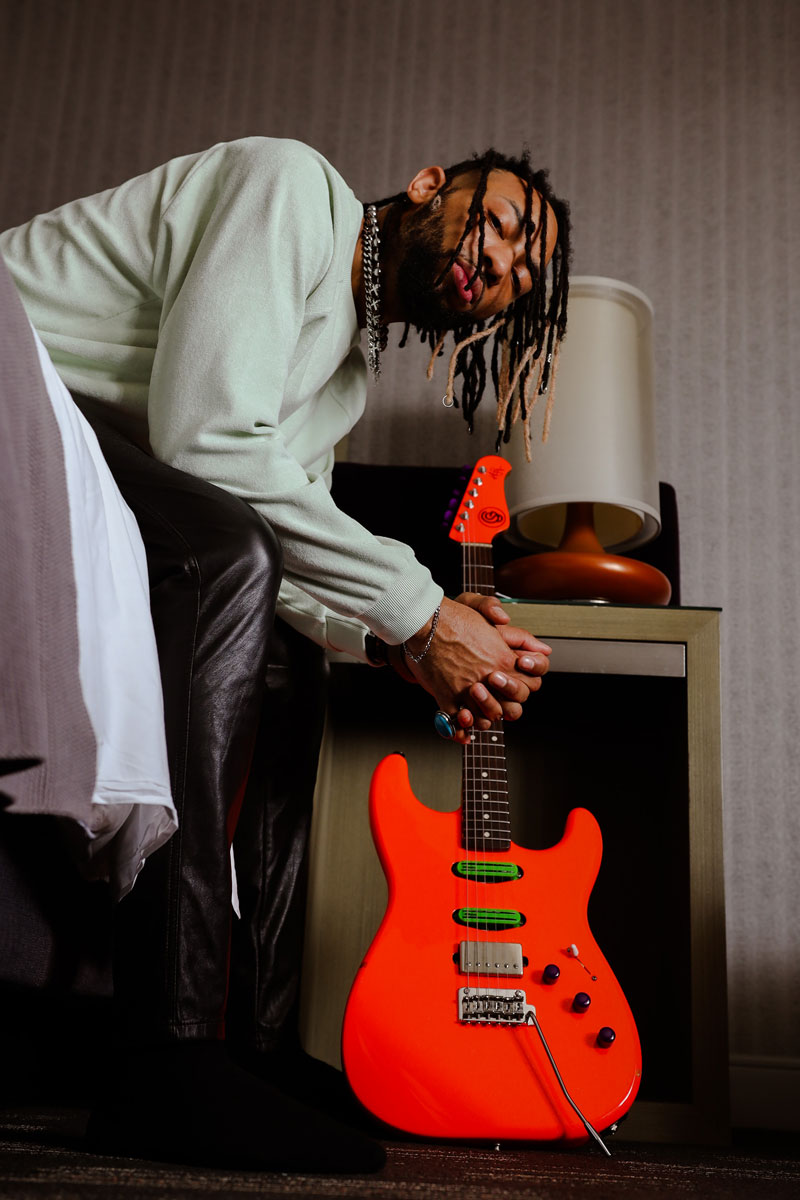
What pedals and amps do you always take with you on tour?
“When there are amps on stage and we don’t have to fight a sound engineer about being too loud, I love using my Triple Rec’ Mesa Boogie, and this Electra Dyne that they discontinued that I just love.
“The tone is so warm and I think I always gravitate to the warmth because of my jazz background. It’s so much better than anything else to me in terms of penetrating the sound on stage when there’s a lot of noise and a lot of subs. It’s so boomy, you just need to have something that really cuts through.
“Then, at first I was a Boss geek and I was rocking the ME-80 for the longest time because I love the analog sound. For so long, the digital tone was too mechanical for me and for my ears. But, as of the past three to five years, they’ve mastered that, so I’ve started using the GT-1000.
“On tour with Machine Gun Kelly, we used a Kemper. Everybody on stage is using Kempers to keep everything consistent. They help a lot because you can emulate the sounds from the actual projects and albums.”
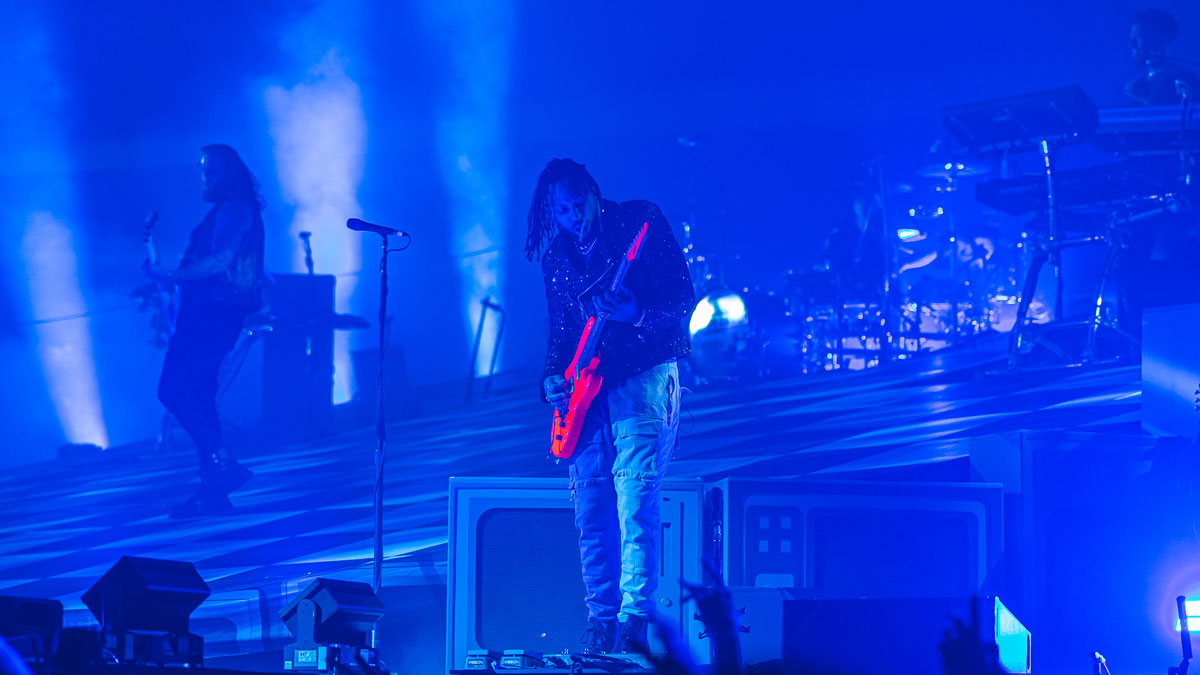
What’s the best tip you could give someone looking to progress towards being ready for professional work?
“First thing’s first, I would say you need to learn how to play with other people. You have to know when to listen, you have to know when the other guy’s turn is, you have to know when it’s not your turn, and you have to know when to jump in and jump out.
“Know who you’re playing with, know what their capabilities are and know what your capabilities are as well because everybody’s on the same team. It doesn’t have to be a competition when you’re all in the same band. Most times you don’t even have to do a lot.
“Those things helped me out a lot with just being aware of everybody else. There’s a keyboard, a drum, a bass, two other guitars, you’ve got singers and vocal tracks, you’ve got sound effects. It doesn’t pay and it doesn’t make sense to add noise. Don’t add noise; add color.”
Since graduating university with a degree in English, Ellie has spent the last decade working in a variety of media, marketing and live events roles. As well as being a regular contributor to GuitarWorld.com, she currently heads up the marketing team of a mid-scale venue in the south-west of England. She started dabbling with guitars around the age of seven and has been borderline obsessed ever since. She has a particular fascination with alternate tunings, is forever hunting for the perfect slide for the smaller-handed guitarist, and derives a sadistic pleasure from bothering her drummer mates with a preference for wonky time signatures.
“His songs are timeless, you can’t tell if they were written in the 1400s or now”: Michael Hurley, guitarist and singer/songwriter known as the ‘Godfather of freak folk,’ dies at 83
“The future is pretty bright”: Norman's Rare Guitars has unearthed another future blues great – and the 15-year-old guitar star has already jammed with Michael Lemmo
